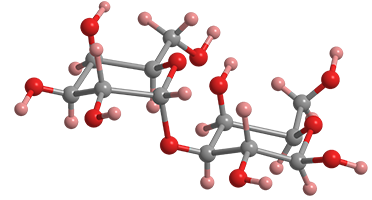What molecule am I?


Galactose-α-1,3-galactose—informally called α-gal—is a disaccharide that is found in the cell membranes of most mammals, but not in humans or some other primates. It does not occur in birds, reptiles, fish, or other non-mammals; but it can be carried by some arachnids.
Two 1959 articles contained early mentions of α-gal. In the first, K. Morgan and A. N. O’Neill* at the National Research Council (Halifax, NS) identified it as a degradation product of λ-carrageenin1, a sulfated polysaccharide. The second, by M. J. Clancy and William J. Whelan* at the University of Miami (Coral Gables, FL), included α-gal in a study of the selective periodate oxidation of reducing-end groups in oligosaccharides.
Certain kinds of ticks can introduce α-gal into the human body, causing “alpha-gal syndrome”, in which the body reacts by becoming overloaded with immunoglobulin E2. The result is an acquired allergy that causes some individuals to contract rashes, hives, nausea, vomiting, low blood pressure, dizziness, or even anaphylaxis several hours after consuming mamallian meat. No remedy exists for the syndrome other than treating its symptoms.
For additional information about galactose-α-1,3-galactose, see the ScienceDirect topics page.
1. CAS Reg. No. 9064-57-7.
2. CAS Reg. No. 37341-29-0.
Galactose-α-1,3-galactose hazard information*
| Hazard class** | GHS code and hazard statement | |
|---|---|---|
| Acute toxicity, oral, category 4 | H302—Harmful if swallowed | |
| Skin corrosion/irritation, category 2 | H315—Causes skin irritation | |
| Serious eye damage/eye irritation, category 2A | H319—Causes serious eye irritation | |
| Specific target organ toxicity, single exposure, respiratory tract irritation, category 3 | H335—May cause respiratory irritation | |
*Information from one safety data sheet; others cite fewer hazards.
**Globally Harmonized System (GHS) of Classification and Labeling of Chemicals. Explanation of pictograms.
MOTW updates
Dimethylmercury1 (Me2Hg) was the Molecule of the Week for January 30, 2023. It is an extremely neurotoxic compound that can be fatal if swallowed, inhaled, or absorbed through the skin. It is also highly flammable and suspected of causing cancer.
Me2Hg occurs in ocean waters and is responsible for the occurrence of mercury in seafood. Last month, Hannah M. Adams, Amina T. Schartup, and colleagues at the Universities of California at San Diego and Santa Cruz reported that Me2Hg is a source of the methylmercury2 cation (MeHg+), the form of mercury found in marine life that is even more lethal than Me2Hg because it can cross the blood–brain barrier. The authors’ findings from the ocean near the California coast challenge current understandings of the source of MeHg+ that contend that the toxin is derived from inorganic mercury.
Artemether3 was one of the Molecules of the Week for July 30, 2018. It is a precursor to the malaria drug artemisinin4 that was developed in the 2010s; but it was abandoned because it is more expensive than natural artemisinin.
In June, Qi-qun Tang at Fudan University (Shanghai) and coauthors there and at other Chinese universities described a potential new use for artemether. They discovered that the compound could be the first effective treatment for polycystic ovary syndrome (PCOS), a widespread endocrine disorder that affects ≈10% of reproductive-age women. In a pilot clinical study of 19 women with PCOS, most of the subjects exhibited fewer symptoms of the syndrome and had more regular menstrual cycles.
1. CAS Reg. No. 593-74-8.
2. CAS Reg. No.22967-92-6
3. CAS Reg. No. 71963-77-4.
4. CAS Reg. No. 63968-64-9.
This molecule was suggested by a reader. We present almost all of the molecules suggested by our readers. If you have a molecule you would like us to consider, please send us a message. And thank you for your interest in Molecule of the Week! —Ed.
Galactose-α-1,3-galactose
fast facts
| CAS Reg. No. | 13168-24-6 |
| SciFindern name | D-Galactose, 3-O-α-D-galactopyranosyl- |
| Empirical formula | C12H22O11 |
| Molar mass | 342.30 g/mol |
| Appearance | White to off-white crystals |
| Meling point | 157–162 °C |
| Water solubility | Slight |

Learn more about this molecule from CAS, the most authoritative and comprehensive source for chemical information.
Molecule of the Week needs your suggestions!
If your favorite molecule is not in our archive, please send us a message. The molecule can be notable for its current or historical importance or for any quirky reason. Thank you!
Stay Ahead of the Chemistry Curve
Learn how ACS can help you stay ahead in the world of chemistry.

